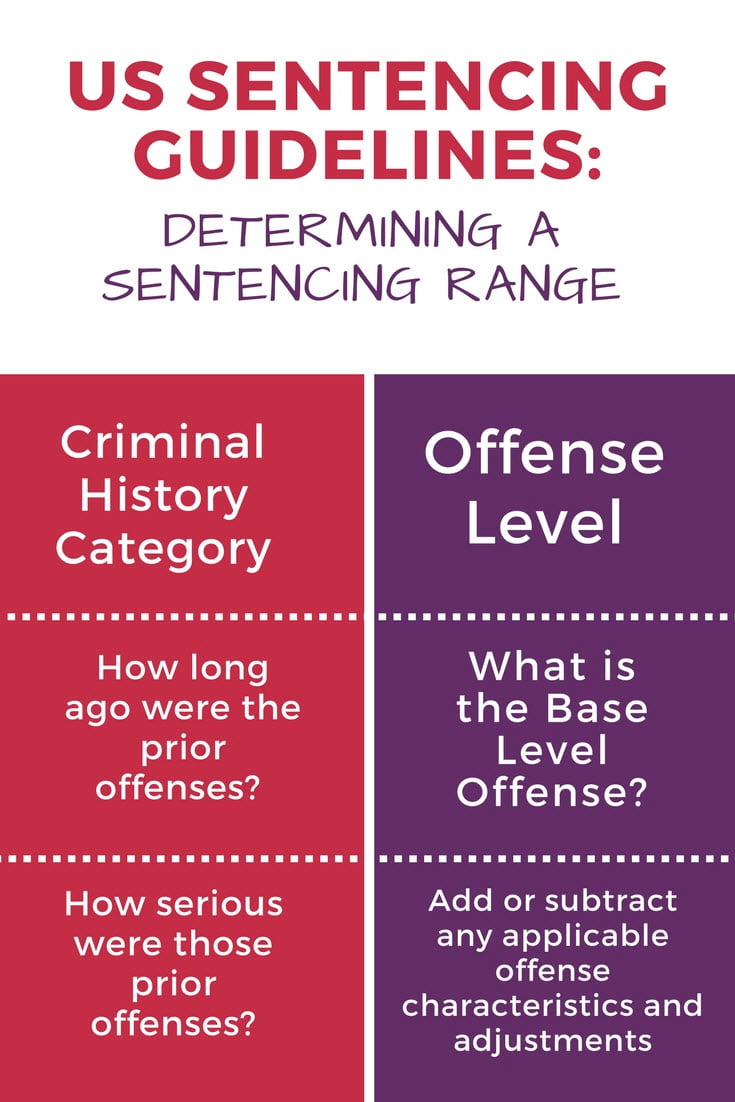If you or a loved one has been contacted by the US Marshals to turn yourself in for an arraignment, you know first hand how scary having federal charges can be.
One minute you are living your life as normal, the next minute your home could be raided and you get caught completely off guard. You may be particularly surprised if you have stopped any criminal behavior and said goodbye to that lifestyle.
However, it is not unusual for a federal case to be brought to court months or even years after the initial criminal activities began. There is no statute of limitations for the Government to bring criminal actions in the District of South Carolina United States District Court.
Once you have been arraigned, reviewed the evidence the Government has against you in your case, you will be very interested to know the specifics about the Federal Sentencing Guidelines. They are important and will no doubt be a major determining factor in your punishment of the crime.
Your future is riding on these guidelines.
Federal Sentencing Guidelines: What are they?
Please first CLICK HERE to see the full Federal Sentencing Guidelines Table.
The Federal Sentencing Guidelines are a set of statutes or “rules” that judges are required to consider that maps out what your sentence could be. The Guidelines are drafted by the United States Sentencing Commission. One of the purposes of the Guidelines is to make sure sentences are not too different in varying locations across the United States for the same crime.
Basically, there are two main factors that affect your sentence:
- The severity of the offense; and
- Your criminal history
Are the US Sentencing Guidelines Mandatory?
No, the Guidelines are only advisory. This means that the sentencing Judge can take the Sentencing Guidelines into consideration, but ultimately, the sentencing judge can chose to depart upward or downward from these guidelines.
The factors that a sentencing Judge would take into account in departing from the Guidelines will largely depend on what your attorney argues at the Sentencing Hearing. Hopefully your attorney will prepare a Sentencing Memorandum for the Judge to review prior to sentencing. The Sentencing Memorandum should include the reasons why the Judge should give you less of a sentence that what the US Sentencing Guidelines suggest based on your criminal history and severity of the case.

The United States Sentencing Guidelines are summarized on right in a chart/grid.
On the left side of the grid, a number from 1 to 43 outlines a number that represents the crime or crimes for which you are currently pleading guilty to.
On the top of the grid, you will see Roman Numerals 1 through 6 (I-VI) which represent your criminal history category.
To determine your sentencing guideline range, you select on the top your criminal history category and then on the left your crime level and the area on the grid where they meet up is your sentencing guideline range.
Make sure that you are looking at the most current Guideline Chart available because the Guidelines Commision changes the guidelines from time to time. You want to be very precise in determining these guidelines because your future in prison, supervised release, parole, or probation is weighing on this Guideline Chart. You want to know what you are facing, so use the most recent chart.
You can check an online sentencing guidelines calculator for an idea of what you may be facing.
Criminal History Categories (The Top of the Grid)
Offenders are assigned to one of 6 criminal history categories. Where you fall in this category of 1 to 6 is based on the extent, or seriousness of your past criminal history.
Do you have misdemeanors, non violent, violent, or felonies on your record?
Second, when was the last time criminal arrests or convictions show up on your criminal record? If you have not had anything on your record for the last 10 or 15 years, the court is going to consider this. Sure, people make regrettable mistakes in their youth but if you learned your lesson and have nothing else on your record since then, the court will take this into consideration. On the other hand, if you have been getting stuff on your criminal record in the last 5 years or so, the court is going to consider this as far as computing points.
The Court will also consider if you have missed court dates, have been on probation or are currently on probation, whether you have violated probation, and any other types of history that can be derived from your criminal record and past history.
The Ranking System
Category 1 (roman numeral I) is the least serious of criminal history categories. If you have no criminal record or very little criminal record points, you will fall into a category I, which is the lowest and best category to be in if you want to decrease your chances of prison time.
On the other hand, the highest and most serious criminal category is a 6 (VI). Being in this category can subject to more federal prison time. Where you fall in these categories is determined by the Federal Sentencing Guidelines. You need an experienced attorney that has the time to sit down with you and explain where and why you fall into which criminal category.
To figure out what criminal history category you fall into, the Sentencing Guidelines and your attorney can help explain.
Juvenile Charges
The Guidelines treat criminal history different than state court. State court only looks at adult convictions. However federal court looks at juvenile convictions. Not only do the Federal Sentencing Guidelines take into juvenile convictions when calculating the criminal history category, they also take arrests without convictions into consideration.
Some other factors are whether you were on probation and if you violated the terms of your probation. If you were sentenced under the Youthful Offender Act, the Guidelines do not treat this as a juvenile conviction; it is treated as an adult conviction.
The Guidelines also take into consideration whether you had an attorney at your hearings. In some cases, the United States Probation and Pretrial Agent that is assigned to your case may request old sentencing sheets, incident reports, indictments, and other documentation to obtain detailed information on your past crimes.
Levels of Offenses (The Left Side of the Grid)
The most serious crimes have higher numbers (the highest number is 43). The less serious crimes have lower numbers (the lowest number is 1).
When you finally determine your criminal history level, you match that up on the grid with your current crime level, and you get a number with a range of months. This number range represents the sentencing guidelines range you are facing.
It is most important that you go over these guidelines with your lawyer as they are very complex. Don’t wait until the last minute to get your lawyer to explain what kind of sentence you are facing. Your future depends on it.
If you don’t understand the Guidelines, get your federal lawyer to explain it to you so it’s easy to understand. That way, on the day of sentencing, you will be confident when you hear the Judge, your lawyer and the US Attorney discussing your sentence on the court’s record. After all, this is your case. Why not understand what is going on?
The Ranking System
Crimes are assigned to one of 43 levels of offense seriousness. For example, murder is assigned a level of 43, while burglary of a residence is assigned a level of 17. These base levels are predetermined and listed in the Guidelines. The numbers have been predetermined by the Sentencing Commission.
Once you have your base level offense, you don’t stop there. You then look at the specific offense characteristics. Those specific offense characteristics are listed in the Guidelines. It is very important to look at each of these specific offense characteristics because they can have an effect on your final number for your criminal offense. You want to have as low a number as possible so you end up with the lowest number of months for a prison sentence.
The Final Offense Level
The Final Offense Level is determined by taking your Base Level (as described above) and adding or subtracting any specific offense characteristics and adjustments that apply.
Your lawyer will help you determine what can be considered in your individual case. This is the portion of your case where your lawyer should be creative in their arguments to the sentencing judge.
For example, if we use our prior Burglary example. The base level is 17, but then that number can increase based on how much property was stolen. The more property that was stolen the higher the number increases. The specifics of how much property was taken (also known as the “specific offense characteristics”) depend on how much that number of 17 will increase can be found in the Guidelines.
Adjustments
Adjustments are yet another factor to consider that can add or subtract levels to the offense level. For example, there are victim related adjustments.
Victim Related Adjustments
This legal jargon translates into something like this: Was there a victim directly involved in the burglary? Was this victim home when the burglary occurred? How old was the victim? Was the victim injured? Was there a deadly weapon used?
In addition to victim-related adjustments, the Guidelines call for the Offender’s role in the offense
Offender’s Role in the Offense
The court will consider if you were the “ringleader” in this case, or if you were a mere lower level participant. Were you involved in the key decision making of this crime or were you taking orders from the higher ups? Did you come up with this crime and how to orchestrate it or were you following the instructions given by someone else?
The points added or subtracted will be based on your lawyer’s arguments of whether you were a minimal participant.
For example, in a large scale, multi defendant indictment on distribution of crack, the court will give more points to the participant who played an active role obtaining incredibly large amounts of cocaine from the distributor (the “kingpin”). Once the product was transported to a location for cooking the powder to crack, there was a cook, who’s sole role in this case was to cook the powder to crack. The cook may not even know the kingpin. The cook may not even gain much of a profit from cooking. The cook may not even know where the powder comes from or how it gets to the traphouse where he or she cooks. The cook could arguably be a minimal participant if he or she only cooks portions of the product and is not involved in the next step of distribution.
If the court determines you had a minimal role in the offense, you could have 4 points subtracted from your base level offense! That can be a huge difference in the amount of time you spend in prison.
Remember, we are trying to get the offense level number as low as possible to reduce the amount of time you spend in prison.
Note that if you have no co-defendants, this part doesn’t really apply to your case because your role in the offense can’t be compared to others’ roles in your case.
Obstruction of Justice
The Court does not reward obstruction of justice. Obstruction of justice will be a motion by the US Attorney to add points to your offense level. Your attorney will be responsible for making a compelling argument that you did not obstruct justice.
So what is obstruction of justice? It is a general term that can include a wide variety of behavior.
For example, if someone testifies during a suppression hearing and commits perjury or intentionally misleads the Court, the US Attorney can ask that you be given extra points for obstruction of justice. To stop the Judge from adding these points, your lawyer should be fully prepared to defend you and explain why you should not be given obstruction of justice charges.
For example, you could have not understood the question asked of you at the Suppression Hearing. You were too nervous to clarify the question so you give an answer that isn’t completely correct. But you didn’t intentionally mislead the court. Your lawyer should provide the transcript of your prior testimony and explain why you do not deserve extra points for obstruction of justice.
Here is yet another example of why having an attorney that is prepared for your sentencing hearing comes in. You literally could have more or less months added to your sentence based on how the judge rules on this issue at sentencing.
Acceptance of Responsibility
The court may award you points for pleading guilty as opposed to going to trial on your case. Of course, you have every right to a trial by jury. However, if the Government has a compelling case against you with lots of evidence and after reviewing that evidence your attorney advises you your best bet is to plead guilty, then you could get 2 points subtracted for acceptance of responsibility.
Departures from the Federal Sentencing Guidelines
Because the Federal Sentencing Guidelines are not mandatory, but advisory, the sentencing judge can depart from the Guidelines. Your lawyer should research how the sentencing Judge has ruled in the past on similar cases with similar circumstances.
Of course, no lawyer can predict how any judge will rule, but it won’t hurt for your lawyer to look into this issue and prepare for possible outcomes. Departures from the Guidelines require a good reason; they are a privilege and not a right. The sentencing judge may require compelling reasons why he or she should depart from the guidelines.
You should be very interested in the arguments that the US Attorney could argue to increase your sentence and your lawyer’s arguments to the contrary.
Have questions about sentencing in your case?
The Federal Sentencing Guidelines can be very confusing, sometimes even to the most seasoned federal criminal defense attorney. It can take years to familiarize yourself with how the Guidelines work, when departures are appropriate and how to develop the best arguments for your case.
Even if your attorney has a good grasp on the Guidelines, your attorney needs to keep up with the ever changing policies of the United States Sentencing Commission. If the policies are changing to your benefit, your attorney needs to tell you this.
If they are changing and not benefiting you, it is equally important for your attorney to keep up with it and let you know.
Attorney Susan Williams receives instant United States Sentencing Commission email updates on how the Guidelines may be changing, proposed changes, and new revisions to the updates.
Susan is licensed in the United States District Court for the District of South Carolina. She served on the Criminal Justice Act Panel attorneys since 2011 and has personally worked on criminal defense cases as lead counsel and gained experience in the United States District Court, District of South Carolina.
Susan also attends Continuing Legal Education to stay up to date on the cutting edge changes in the United States Guidelines. She has attended the following educational courses devoted specifically to Federal Law:
| Date of Course | Title | Credit Hours |
|---|---|---|
| 5/1/09 | CJA Mini Seminar | 4.0 |
| 7/30/09 | Advanced Sentencing Guidelines | 6.25 |
| 8/20/10 | Charleston Mid Summer Seminar | 1.75 |
| 10/28/10 | Federal Criminal Practice | 6.5 |
| 10/20/11 | Federal Criminal Practice | 6.0 |
| 9/26/12 | US Sentencing Guidelines | 6.0 |
| 10/25/12 | Federal Criminal Practice | 5.0 |
| 8/20/14 | US Sentencing Guidelines Seminar | 6.0 |
| 10/30/14 | Federal Criminal Practice | 6.0 |
| 8/18/15 | US Sentencing Guidelines Seminar | 6.0 |
| 10/29/15 | Federal Criminal Practice | 2.2 |
| 10/20/16 | Federal Criminal Practice | 6.0 |
| Planning to attend
7/10/18 |
US Sentencing Guidelines Seminar | 6.0 |
You can contact me today to discuss your case. Call 843-607-9800 now to speak to me.



